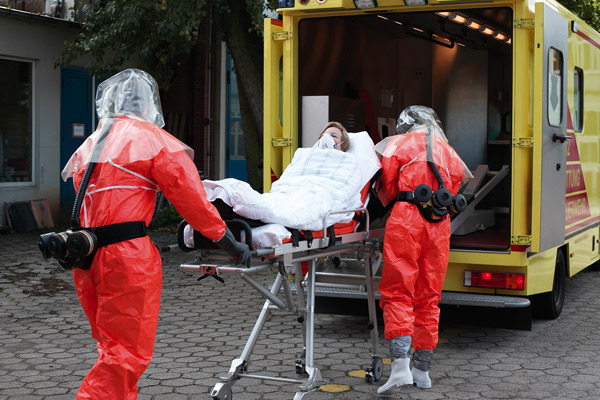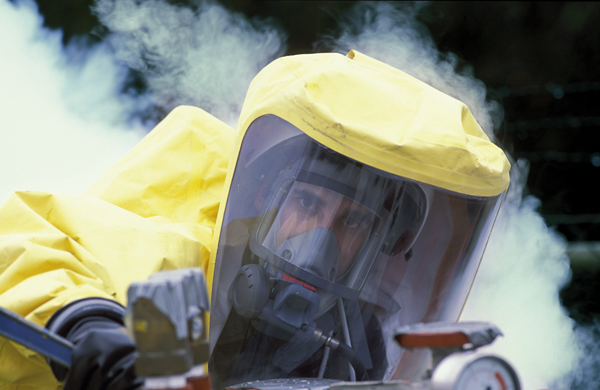
© SATRA Technology Centre. Reproduction is not permitted in any form without prior written permission from SATRA.

Chemical suits – part 2
Workers in the emergency services can choose different levels of protective clothing to suit the circumstances.

The threat of terrorist attacks utilising chemical, biological or radiological agents remains at a high level. Protective suits have been available to the military for many years, but in recognition of the heightened terrorist threat and, indeed, of the danger posed by an accidental release of toxic substances, there is a need to provide emergency services with suitable protective equipment in the event of an incident.
BS 8467:2006 – 'Protective clothing – Personal protective ensembles for use against chemical, biological, radiological and nuclear (CBRN) agents' covers categorisation, performance requirements and test methods relating to personal protective equipment (PPE) products. There are no specific European standards covering CBRN for non-military use, and BS 8467 has been developed using existing test methods and protocol to facilitate ease of testing and the CE-marking process. While military protective clothing is exempt, occupational garments for non-military applications need to comply with the Personal Protective Equipment (PPE) Regulation.
BS 8467 contains performance requirements and test methods for protective ensembles including garments, gloves, footwear and eye, face and respiratory protection. Four levels of performance are recognised and these are known as categories 'A' to 'D', where A provides the highest level of protection and D the lowest.
The principle behind the categorisation in this standard is to provide emergency services personnel with a range of protection to suit the circumstances. For instance, people operating very close to the centre of an incident where the concentration of an agent is known to be high (or indeed where it is not known) require a very high level of protection. At the opposite extreme, emergency services operating a long way from the incident or where the risk level has already been established as low, require a lower level of protection, perhaps for wearing over a period of several hours.
Levels of protection
Category A consists of gas-tight suits with an independent air supply and would be suitable where high levels of a gas, vapour, aerosol, liquid or particulates may be present. Such a situation might occur following an unintended leak at a chemical plant or an accident with a road tanker. Alternatively, it could be due to deliberate action, and in such cases the concentration and indeed the nature of the agent might not be known initially. It is recognised that the protection provided by such equipment might be at the expense of wear-time, mobility and comfort. Such ensembles should conform to EN 943-2, the standard for emergency team gas-tight suits.
It is intended that category B equipment can be worn for longer periods or periods of high physical activity in situations where contact with contaminated surfaces and residual vapours may occur. The nature and quantity/concentration of the contamination agent will have been evaluated. Two sub-groups, 'B1' and 'B2' are envisaged, where B1 is intended for use in environments with high levels of vapour but a breathable level of oxygen, and B2 is intended for use in environments where hazardous liquids are present and a breathable level of oxygen is also available. Such protection would be provided by liquid-tight ensembles meeting type 3a or type 3b emergency team PPE according to BS 8428.
Category C equipment is for use where the exposure is to low levels of known agents and where risk of skin contact is minimal. It is envisaged that such suits would be used in activities such as the rescue of casualties from collapsed building, so a high level of mechanical strength would be required of the garment. Garments meeting EN 469:2005 – 'Protective clothing for fire-fighters' are likely to meet the requirements for physical strength, dimensional stability, surface wetting, resistance to chemical penetration, resistance to water penetration and resistance to ignition. However, the thermal properties required in EN 469:2005 are not required. Suitable respiratory protection, head protection, eye protection and protection for the hands and feet are also necessary.
Category D equipment would be used where only very low levels of contaminants exist, either because users are operating a long way from the centre of the incident or because they are operating a long time after the incident. The environment will have been assessed as very low risk, with personal contamination being unlikely. The basic chemical suit could consist of a type 6 suit conforming to EN 13034:2005.
Threat from the atmosphere
Preventing inward leakage of airborne particulates is a key requirement. All categories of protection under this standard are required to meet an inward leakage performance level of 0.01 per cent or better for category A, 0.05 per cent or better for category B and 0.1 per cent or better for categories C and D. A range of test methods is described, including using human subjects wearing the ensembles while walking on a rolling road in a test atmosphere. Other methods involve the use of a dynamic manikin in live agent tests. Test atmospheres for manikin-type tests could be, for instance, distilled sulphur mustard HD, Sarin GB, Soman GD or V-agent. For human subject tests, an atmosphere with sodium chloride aerosols is used.
All materials used in the ensembles must also be assessed for their resistance to the permeation of distilled sulphur mustard HD, Sarin GB, Soman GD or V-agent. These tests are in addition to any permeation testing or penetration testing which the various items in the ensemble may have already undergone. For example, EN 943-2 includes a test bank of 15 chemicals – including both liquids and gases – against which all the components of the ensemble must protect. The permeation test specified in BS 8467, however, requires a specific quantity of chemical to be applied to the test piece. For category A, this concentration is 100g/m2, while for B, C and D it is 10 g/m2. The maximum cumulative permeation over four hours should be no more than 1.25 µg/cm2.

Image © Trelleborg Protective Products
Emergency workers at the heart of an incident require gas-tight suits with independent air supply
Other components
While this article concentrates on clothing, it is vital that suitable protection for the hands, feet, head/face/eyes and respiratory system is also provided. Normative references in BS 8467 detail harmonised European standards to be used covering these products.
All of the ensembles in BS 8467 are composed of several items of personal protective equipment and therefore they fall within the scope of the PPE Regulation unless manufactured specifically for the armed services or police.
Further information on SATRA's PPE certification and testing services is available at www.satra.com/ppe
How can we help?
15 PER CENT DISCOUNT ON FIRST SATRA TEST — please click here.
SATRA is able to test and certify protective clothing and equipment against the PPE Regulation. SATRA is also able to carry out the ongoing audit of production of such items. Please email ppe@satra.com for more information.


 EN
EN ZH
ZH